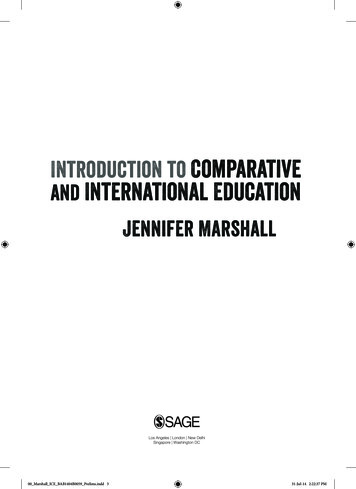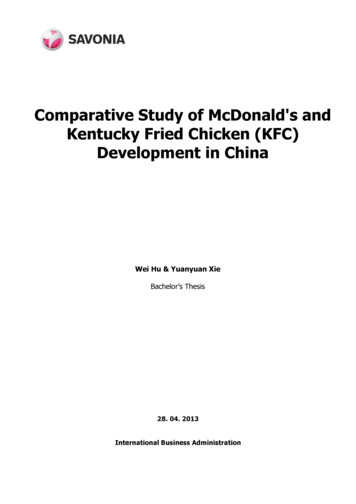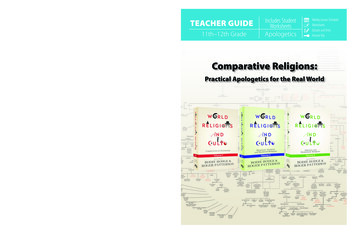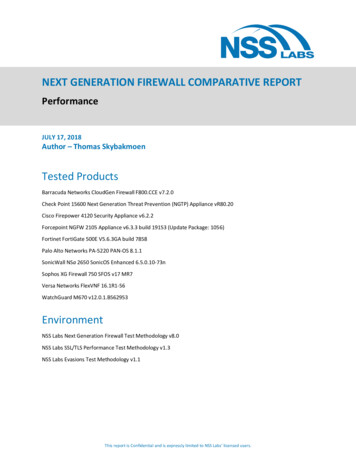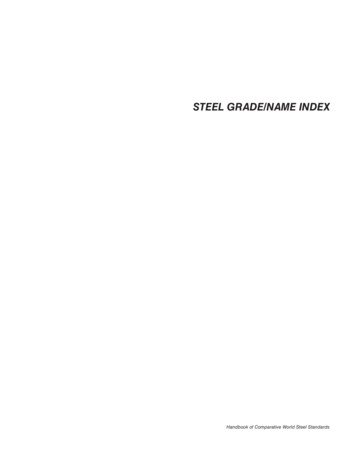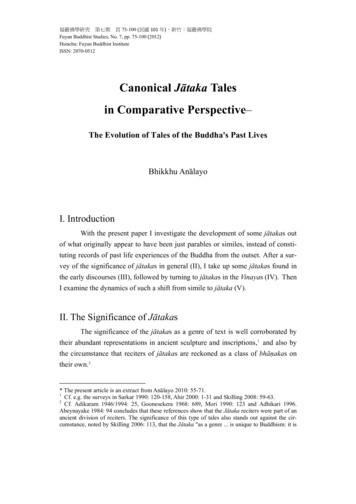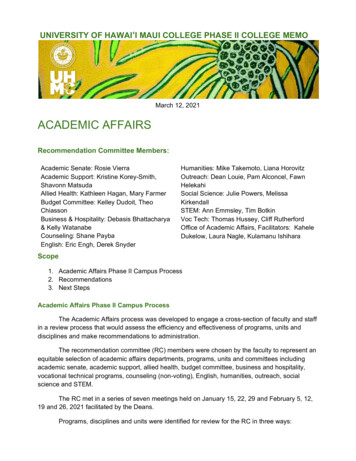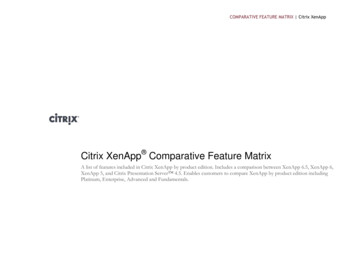
Transcription
Units 1-9COURSE CODE: 6466COMPARATIVE EDUCATIONFaculty of Education, Distance, Non-Formal & Continuing EducationDepartment, Allama Iqbal Open University, 20161
COURSE TEAMChairmanDr. Muhammad Ajmal ChaudharyMembersDr. Muhammad Ajmal ChaudharyMs. Naila NaseerDr. Amtul HafeezMs. Mamoona AmbreenDr. Rahmatullah BhattiDr. AftabDr. Muhammad Zafar IqbalCourse Development CoordinatorMs. Naila NaseerEditorMs. Humaira EjazReviewersProf. Dr. Nasir MahmoodDr. Muhammad Ajmal ChaudharyMs. Naila NaseerMs. Tahira BibiMs. Mamoona AmbreenCourse CoordinatorMs. Naila Naseer2
FOREWORDComparative education is a field of study which makes comparisons between educationaltheories and practices and provides information about similarities and differences in educationalsystems in different countries.This course has been developed to provide an opportunity to the learners to have a deepoverview and understanding regarding the significance and scope of comparative education.Different units of this course will help students to learn about educational practices of differentcountries at different levels (primary education, secondary education, higher education, teachereducation and special education). It will promote the understanding of students regarding thedistance education systems in developed and developing countries. Students will developcomparative analytical skills regarding curriculum planning and development in differentcountries. Overall, this course will facilitate students to relate educational practices of othercountries with our education system so that they can compare and contrast between the local andglobal educational practices.It is very important to equip our students with the necessary knowledge and approachesregarding comparative education so that they may understand relationship between educationand development in different societies. In this regard, I congratulate the Dean Faculty ofEducation and the course team for developing this course.Prof. Dr. Shahid SiddiquiVice ChancellorAllama Iqbal Open University3
ACKNOWLEDGEMENTSThe course is developed by the input of many people. The course developmentcoordinator acknowledges the hardwork and efforts of all the people (Chairman DNFCE, DeanF/O Education, unit writers, unit reviewers, editors, designers and the course team) who put theirknowledge and expertise in the development process of this course with dedication and devotion.I am also grateful to the Vice Chancellor Allama Iqbal Open University for providingfacilities and encouragement for writing this course.(Ms. Naila Naseer)Course Development Coordinator4
INTRODUCTIONBasic rationale for the development of this course is that many important educationalqueries can be best analyzed from an international-comparative perspective. So, the coursefocuses on the study of concept, historical perspectives, trends/issues and educational systems incomparative perspective. Different units of this course will help pupils to know the educationalpractices at primary education, secondary education, higher education, teacher education andspecial education in many countries. It will enhance the students’ understanding regarding thedistance education systems in different countries. The course will also foster comparativeanalytical skills in students regarding curriculum planning and development.The course tends to enhance the understanding of the different educational practices andcross cultural understanding of educational ideas, approaches and challenges in students. Overall,the course focuses on significance of comparative education and its application in our scenario soa better educational system may evolve.5
OBJECTIVES OF THE COURSEThe objectives of this course are to enable students to:1. analyze the concept and scope of comparative education.2. differentiate among approaches of comparative education.3. evaluate primary education in comparative perspective.4. analyze secondary education in comparative perspective.5. critically analyze higher education in comparative perspective.6. discuss the status of teacher education in comparative perspective.7. plan and develop curriculum in perspective of different countries.8. evaluate different distance education system in different countries of the world.6
TABLE OF CONTENTSCourse TeamForewordAcknowledgementsObjectives of the CourseUnit 1 Comparative Education: Introduction1. Introduction2. Objectives3. Concept and Scope of Comparative Educationa. The Concept of Comparative Educationb. The Scope of Comparative Education4. Comparative Vs International Education: An Analysis5. Historical Development of Comparative Education6. Comparative Education: Trends and IssuesUnit No.2Concept of Educational Approaches1. Introduction2. Objectives3. Concept and Scope of Educational Approaches4. Types of Educational Approaches5. Descriptive Approacha. Classical Approachb. Standard or Spiral Approach6. Historical Approacha. Prescriptive Approach7. Quantitative Approach8. Sociological Approach9. Conflict Theory10. Open System Theory7
Unit No. 3Primary Education1. Introduction2. Objectives3. Nature of Primary Education4. Concept and Scope of Primary Education5. Primary Education in Comparative Perspectives:a. Primary Education in USAb. Primary Education in UKc. Primary Education in Pakistand. Primary Education in Sri LankaUnit No. 4Secondary Education1. Introduction2. Objectives3. Concept and Scope of Secondary Education4. Secondary Education in Comparative Perspectivesa. Secondary Education in USAb. Secondary Education in UKc. Secondary Education in Indiad. Secondary Education in Pakistane. Secondary Education in Malaysia5. Comparison between Eastern and western countries in secondary educationUnit No 5Higher Education1. Introduction2. Objectives3. Concept and Scope of Higher educationa. Concept of Higher Educationb. Scope of Higher Education4. Bologna Process in Higher Education8
5. University Education in Comparative Perspectives:a. United States of America (USA)b. UKc. Pakistand. IndiaUnit No. 6Teacher Education1. Introduction2. Objectives3. Concept of Teacher Education4. Scope of Teacher Education5. Teacher Education in Comparative Perspectivea. USAb. UKc. Pakistand. IndiaUnit No. 7Special Education1. Introduction2. Objectives3. The Concept and Scope of Special Education:4. Special Education in:a. Pakistanb. United Kingdomc. Indiad. NorwayUnit No. 8Curriculum Planning and Development1. Introduction2. Objectives9
3. Curriculum Planning4. Curriculum Development5. Concept and Scope of Curriculum Development6. Essential Considerations for Curriculum Development7. Phases and Steps in Curriculum Development8. Curriculum Development in Comparative Perspectives:a. Curriculum Development in United States of Americab. Curriculum Development in United Kingdomc. Curriculum Development in Indiad. Curriculum Development in PakistanUnit No. 9Comparison: Distance Education System1. Introduction2. Objectives3. Concept and Scope of Distance Education System4. Comparative Distance Education System:a. Canadab. UKc. Pakistand. India5. Comparisons of different Distance Education Systems10
Comparative Education: IntroductionWritten by: Prof. Dr. Tanveer-uz-zamanReviewed by: Prof. Dr. Nasir MahmoodTABLE OF CONTENTSIntroductionObjectivesConcept and Scope of Comparative Education The Concept of Comparative Education The Scope of Comparative EducationComparative Vs International Education: An Analysis.Historical Development of Comparative EducationComparative Education: Trends and Issues11
ReferencesINTRODUCTION:Collection of data on educational systems in different regions has been rapidly growingsince the 19th century. Comparative education is the comparative study of educational theoriesand practices in various countries. Comparative education attempts to use cross-national data totest propositions about the relationship between education and society and between teachingpractices and learning outcomes. Comparative education considers the implications ofcomparative studies for the formation and implementation of policies in education, social,national and international development. Comparative analysis in education proved to be a usefultool in the science of education from a number of standpoints. It provides us with knowledge andinformation on other countries' educational systems, practices and outputs. It also providesdescriptions of other nations' lifestyles including their educational practices.Comparative education invites contributions from associated disciplines in the fields ofgovernment, management, sociology, and technology and communications which affect12
educational research and policy decisions. Comparative education aims at a) explainingeducational systems, processes, or outcomes; b) helping the development of educationalinstitutions and practices; c) emphasizing the relationships between education and society; and d)forming generalized statements about education relevant in more than one country.In fact, students in educational institutions are not prepared without the study ofcomparative education due to the justifiable reasons that is: comparative education providesreference for reforms. Through studying the educational systems of other countries we candiscover which reforms are possible and desirable. The study helps students to improve theeducation in their home country. Comparative education helps students to acquire betterunderstanding of education system of other countries and borrow some aspects for betterimprovement of education at home. Comparative education contributes to the internalization ofschool curriculum and student learning experience; develop students’ broader world views,cross–cultural and comparative analytical skills. Similarly, the study of comparative educationhelps students to make connection between the local and global, and the relationship betweeneducation, development and society.Furthermore, comparative education help students to understand how educational systems areshaped by wealth, ideology, social cultural features of the country and impacts of globalizationon education policy and practice in different regions and countries (Lawrent, 2012).Objectives:After studying this unit, students will be able to:1. Explore the concept and scope of comparative education.2. Comprehend comparative versus international education.3. Grasp the historical perspective of comparative education.4. Identify trends and issues of comparative education.1.1 Concept and Scope of Comparative Education:Following is the concept and scope of comparative education:1.1.1The Concept of Comparative Education:Comparative educationists are primarily scholars who study education in differentenvironments in order to discover why they are the way they are and also attempt to solve13
educational problems. Comparative education is a multi-disciplinary subject that uses knowledgefrom other humanities and social sciences disciplines.Sodhi (2006) perceives comparative education as a field of study that applies historical,philosophical and social science theories and methods to international problems in education.Getao (1996) defined Comparative Education as a discipline, the study of educationalsystems in which one seeks to understand the similarities and differences among educationalsystems.As a summary of the definitions of comparative education, it can be said that it is a disciplinethrough which one makes comparisons of education systems across national boundaries byexamining in detail the structure, curriculum, administration, financing and participation, withthe aim of understanding the factors and forces that account for the differences and similarities inthese systems of education.1.1.2The Scope of Comparative Education:Evans (2013) has elaborated the scope of comparative education under following fiveperspectives:i.The subject matter and content; this covers the essential components of educationalsystems such as structure, aims, content or curriculum, administration, financing,teacher education.ii.Geographical units of study; these comprises intra-national, international, regional,continental and global or world systems studies and analysis.iii.Ideological scope; this compares countries' educational systems on the basis ofdifferent political, social and economic ideologies. For example, democratic,communism, socialist, capitalist, free market and mixed economies.iv.Thematic scope; this scope focuses on educational themes, topical issues orproblems and compares them within one or more geographical units. For examplefree primary and secondary education, universal primary education, education for alland universal higher education.v.The historical or spatial scope; this deals with the study of the historicaldevelopment of the discipline from the earliest (pre-historic) phase known as the14
period of Travelers' Tales to the modern phase known as the period of social scienceperspectives.So, it is apparent that the scope of comparative education could be viewed in thefollowing ways: First there is the subject matter/content perspective which covers the essentialcomponents of educational systems such as aims, content or curriculum,administration, financing, teacher education and structure. Secondly, there is the geographical unit/area study perspective which comprises intranational, international, regional, continental and global or world systems studies andanalysis. Intra-national studies involve studies done within a nation. The nationalstudies may involve several nations within a region or a continent. Then there is also the ideological approach, which compares countries educationalsystems on the basis of differing political, social and economic ideologies that arefollowed. The national philosophy in a country influences the kind of the education that isprovided. This can further be affected by the political party manifestoes thatpropagate a particular ideology. The Socialist countries have used socialism as themain ideology that is followed in their countries and this has affected the educationsystem in those countries. On the other hand Western countries have used severalideologies such as pragmatism, nationalism and democracy in furthering theireducational ideals. The thematic scope focuses on themes, topical issues or problemsand compares them within one or more geographical units. This can further be doneby analyzing of a topical issue in education and understanding it. Lastly the special/ historical scope deals with the study of historical development ofeducation.15
Activity No. 1.1. Discuss the term comparative education with at least two educationalists and write its definition inyour own words.2. Go to the library and find out the concept of comparative education and write it in your own words.3. With reference to at least two scholars, write down the scope of comparative education in your ownwords.1.2Comparative Vs International Education: An Analysis:Comparative education has following international relevance and impacts: Education for international understanding:According to Mugo and Wolhuter (2011) international understanding is a central purpose forstudying comparative education. Unilateral and multilateral co-operation programs have beendeveloped to promote international understanding. Education is seen as the possible way toenhance international understanding. To understand other nations of the world, their philosophiesof life, education, culture and sociology and to understand the forces, geographical, cultural,local and religious factors influencing their life, to know more about their customs, traditions andculture is absolutely essential. An understanding of how these cultures are affecting educationsystems and how these cultures are shaped by education is important for the development ofclear concept of internationalism. Exchanging students, teachers and other social workers isintended to promote the international systems of education. Relax national pride:This is necessary for combat feelings of superiority, especially among, the populations ofcountries technologically and economically developed and with military prowess. They need tounderstand that other countries are essential for their sustenance and therefore have to work formutual benefit of each other.Kubow and Fossum (2007) have discussed that comparative thinking and internationalperspectives taking are essential for citizens to get along in diverse, global society. Comparisonchallenges students to suspend judgment of these foreign systems that they might base on theirlimited and localized perspectives. Through the development of comparative thinking skills,students should be able to undertake analyses of their home cultures and systems with a more16
nuanced understanding of various cultural factors at play. Comparative education alsoencourages students and educators to ask, "What kinds of educational policy, planning, andteaching are appropriate for what kind of society?" The field of Comparative Education focusesour attention on what might be the appropriate and inappropriate policy, while fosteringawareness of the ideologies underlying educational practice. Hence, comparative study can alsocultivate a political consciousness.Since, comparative education studies operate on different geographical levels, so the utilityand value of comparative education is different. It can be viewed at the different levels i.e.:o The global level,o The supra-national,o The national,o The sub-national,o The institutional,On a global level, the significance of comparative education has been raised by thephenomenon of globalization. For example, according to Larsen et al. (2008: 148) andO'Sullivan (2008: 140) globalization has resulted in a renaissance of comparative education inteacher education programs at respectively Canadian and Irish universities. ComparativeEducation identifies and describes world trends and movements in education. Forces ofglobalization have acted upon education internationally, creating greater uniformity andstandardization. Planet-wide societal (economic, political, social and technological) forces havecome to shape education, and need to be taken cognizance of in order to understand education.Comparativists involve themselves in the universal evaluation of education systems globally byassessing how these systems live up to global trends and challenges of the twenty-first century.The Millennium Developmental Goals and the campaign for Education for All are globaleducation policies. Similarly, global initiatives such as universal adult literacy, the MillenniumDevelopment Goals and Education for All call for the expertise of comparativists to assist witheducational planning in order to achieve these goals. Current world wide trends such as theinformation and communication revolution, the technological revolution, and the neoliberaleconomic revolution at the same time hold the possibility of dragging humanity in the twentyfirst century to new, unfathomed depths, and the promise to uplift humanity to unprecedented17
planes; placing at the door of comparative education the assignment of helping education to steerthe world towards the latter.On the supra-national level, a substantial amount of literature focuses on the nature ofeducational provision in different regions of the world. Regional units are constructed on one ormore (educational or contextual) characteristics common to the region. Such characteristicsobtain increased significance if they distinguish the particular region from other regions.Characteristics can include level of educational development, goals of education, forms ofeducational administration, institutional fabric of educational institutions, or contextualcharacteristics such as political organization, colonial history, cultural origin, or level ofeconomic development. For a complete understanding of national systems of education andindividual institutions, it is necessary to turn to regional forces. Regional foci also enlarge thegeographic range of educational planning and philanthropic activities.The level of the nation-state is, of course, the level at which the overwhelming majority ofpublished comparative education studies occurs. Here comparative education studies describeand explain (from societal forces shaping education systems) national education systems.Comparative education research invokes the educational experience of foreign countries to guideeducational reform projects in the home country. National level studies in the field ofcomparative education can also be of value to other fields of educational inquiry. Combinationsof national, political, social and economic forces result in configurations of societies discernibleat national level, and by explicating such national education societal interrelationships,comparative education yields valuable information to the field of sociology of education. It iswhen an education system requires a nation-wide change that comparative education serves thephilanthropic ideal at national level.Current worldwide societal trends of the demise of the once omnipotent nation-state, theresulting decentralization, and the rise of multicultural societies, bring the sub-nationalcategory as level of comparative analysis to the fore. In Germany, for example, the challenge ofthe educational handling of the substantial number of immigrant (guest worker) children, in thesecond half of the twentieth century played a pivotal role in the rise of comparative education as18
a field of teaching in German universities and in the rise of comparative education as anorganized field of scholarly inquiry in Germany (Waterkamp, 2008, p.66). A paradigm such asfeministic studies reveals the experience of women in education, and understanding thisexperience is the first step towards re-designing education systems and teaching practice torectify any wrong. It is also by assessing equity in educational systems, not only with respect tothe trinity gender, ethnicity/race and socioeconomic status, but also with respect to other, newer,contemporary dimensions of diversity, that comparative education plays its part in evaluatingeducation systems. A more positive message emanates from studies in the paradigm of culturalrevitalization. The cultural revitalization paradigm focuses on deliberative efforts by members ofa society to create a more satisfying culture, both at local and national levels, by means ofeducational initiatives.At the level of the institution, the paradigm of ethnography (focusing on the culture of aparticular educational institution), a fuller description of a school or other educational institutioncould be obtained, as well as a more complete understanding. On the level of the class, theparadigms of ethnography (studying the culture of a particular class) and of critical ethnography,as well as the paradigm of ethno-methodology (studying the social dynamics and norms within aparticular class) can be valuable in knowing and understanding what is happening at class-roomlevel. Planel (2008) did an empirical study of 10 student teachers from England doing theirteaching practice in France, that comparative education in teacher education courses should bereconstructed as comparative pedagogy. In times of increasing multicultural classrooms,comprehensive schools and inclusive education, Planel argues that comparative pedagogy isuseful and relevant for teachers as it helps to enhance teachers' understanding of children ofdiverse socio-economic and cultural backgrounds, and thus culminates in more effective teachingand learning, in view of the importance of teaching to have resonance with, to be linked to thelife-world of the students. In an age of individualization and human rights, the individual level isdestined to assume ever increasing importance in comparative education.19
Activity No. 2.1. Discuss to analyze comparative vs. international education in detail with the educationists’ ofAIOU.2. Use the central library of AIOU to understand the perspective of comparative education at theglobal level.3. Ask your two teachers the perspective of comparative education at the supra-national level toexplain it in your own words.4. How the perspective of comparative education at the sub-national level can be explained toyour students?5. Make a group of your students to understand the perspective of comparative education at theinstitutional level.1.3Historical Development of Comparative Education:The history of comparative education can be traced from the earliest times of humanhistory. In education circles reformers and educationists have been comparing their system withthat found in other countries in order to improve their own. Comparative education is a fullyestablished academic field of study that examines education in one country (or group ofcountries) by using data and insights drawn from the practices and situation in another country,or countries. Programs and courses in comparative education are offered in many universitiesthroughout the world, and relevant studies are regularly published in scholarly journals. The fieldof comparative education is supported by many projects associated with UNESCO and thenational education ministries of various nations.Evans (2013) has elaborated the following historical phases of comparative education: The phase of Travelers Tales i.e. Pre-history to end of 18th century. Period of Pioneers or Phase of Selective Education Borrowing i.e. during the19th century. The phase of concern for Cultural Context or Period of Philosophers i.e. from 1900 toend of World War II. The phase of Social Science perspective i.e. from1945 to the present.20
1. The Phase of Traveler’s TalesHistorically people visited places for various reasons such as commerce, conversation,curiosity or conflict. However everyone who has ever been interested in the upbringing ofchildren or in education in general has always tended to find out what goes on in othercommunities. Studies of early writers of comparative education indicate that they drew examplesfrom other societies that they visited or heard about. They actually tended to look for differencesand similarities in respect to education of other communities and their own.This phase was marked by descriptive reports of travelers who comprised militaryconquerors, business expeditions and even explorers. The motives for accounts of travelers' taleswere partly curiosity and the need for comparison. They gave descriptive account of features inforeign systems of educational as they saw them. Their reports on education was fragmental,generally unsystematic, exaggerated at times and understatements at other times. Although theywere stimulating they were superficial and piecemeal and as such were of little comparativevalue but worth considering. Some of the contributors during this phase were:Herodotus (484-425 BC) - in his commentaries on the Persian wars he attempted a comparisonof culture.Xenophon (430-355 BC) -An Athenian, he gave a detailed account of the education forcitizenship given to the youth in Persia. He compared the aims and structure of education inPersian and Sparta. According to him, he admired the Spartan education and wished that theAthenians could copy it.Plato- A Greek philosopher compared the aims and structure of the Spartan and Greek systems.In his two books i.e. "The law" and "The Republic" he compared education system in Sparta andAthens. Like Xenophon he admired the Spartan education system which was state controlled andemphasized on discipline which was military type. He went ahead and argued that the Athenianeducation was likely to bring about permissiveness and lack of social order. He thereforerecommended that the Athenians should copy Sparta.Julius Caesar (102-42BC) - As the Roman emperor he also described how children wereeducated in countries beyond Rome. He also admired especially the Spartan state controllededucation system. He also commented on education of the Belgian, Acquitanians and Celts asindicated in his writings on Gallic wars.21
Cicero (106-43BC) - He made comparisons between Greek and Roman education. In his book"De Republica" (57BC) he explained that he favored state controlled system as opposed to afamily centered system. In his "De Oratore" he claimed that Greece was far better than everyother nation in the practice of eloquence and hence in education.Tacitus (AD 55-116) - He contrasted the education in his own day with that of earlier periods,He even began the long history of the ‘'past versus the present" debate.Marco Polo (13th century) - He traveled to the court of Kublai Khan in China and reportedabout the Chinese education system. He observed that there were no quarrels in schools in Chinaand that honesty and truthfulness were emphasized. He further observed that men and womenlived together peacefully in China a fact he attributed to the education system. However in the19th century it was noted that the Chinese education system contributed to the corruptgovernment system and breaking of laws such as cruelty to prisoners.Ibn Khaldun (1332-1506) -A Tunisian born scholar who made comparison between the EasternMoslem culture and that of the west. He emphasized the need to establish similarities anddifferences between the present and the past. He also advocated for the need to know the causesof the similarities in certain cases and of the differences in others.Jacop Middendorp (German) -was sent by his government to find information aboutuniversities in France, Italy, Denmark, Poland and Bohemia.Erasmus (1496-1536) - a scholar during the Renaissance, he gave detailed information abouteducation in different countries, comparing the state of education in England in his time with thatof Italy.Montaigne (1533-1592) - From France he traveled widely to Germany, Italy and other Europeancountries and gave acco
free primary and secondary education, universal primary education, education for all and universal higher education. v. The historical or spatial scope; this deals with the study of the historical development of the disci
